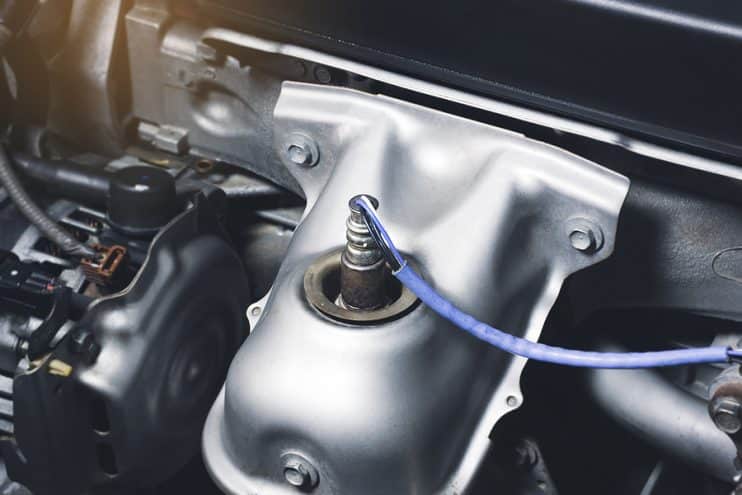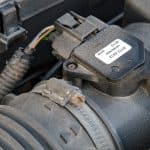
Oxygen sensors are a crucial part of your vehicle’s engine. Each one checks and monitors the flow of air through the system, measuring the amount of oxygen coming into the engine and then leaving the engine by the exhaust. This data then goes on to regulate important fuel monitoring and delivery systems, MPG and timing functions and emissions release.
Even though it’s a small part, when it goes wrong it can cause big problems within the engine that rely on this information. How can you tell when there’s an issue with your oxygen sensor?
Table of contents:
- The Common Problems with a Faulty Oxygen Sensor
- How Much will a Replacement Oxygen Sensor Cost Me?
- Is it Safe to Drive with a Faulty Oxygen Sensor?
- Can I Replace the Oxygen Sensor Myself?
- A Final Note
The Common Problems with a Faulty Oxygen Sensor
Be aware of the following problems with your car, which could point towards a faulty or broken oxygen sensor:
Check Engine Light
There are several problems that could cause the check engine light to switch on. Normally this will be triggered when the engine control module cannot get an accurate oxygen reading from the part. One of the most common is an issue with the oxygen sensor, which can be verified using an OBD scanner. Best course of action is to have the vehicle checked out by a professional to determine the culprit behind the light.
Failing Emissions Test
Because the oxygen sensor is used to regulate the air fuel mix, if the balance in the mix is wrong, then this will lead to excess emissions within the exhaust gasses. As a result, if the oxygen sensor is broken or malfunctioning, then this will lead to your vehicle failing its emissions test.

Poor Fuel Economy
Again, if the air fuel mix is unregulated, this will make the engine struggle to combust properly. You might find yourself having to refill the tank more regularly if the oxygen sensor is malfunctioning or broken, as the car will fail to burn through fuel properly, requiring excess fuel to create the same momentum available when the sensor is working normally.
The excess fuel entering the engine is not good for the environment either, as this will lead to increased emissions leaving your vehicle.
Poor Handling, Rough Idling and Stalling
Problems with the air fuel mix won’t only impact the fuel economy of your vehicle. Failing sensors will cause power loss, poor response from the engine and even stalling when starting up because of problematic messages from the sensor disrupting normal engine functions.
Additionally, if the mix of oxygen entering the combustion chambers of your car’s pistons is not regulated by a properly functioning sensor, then can cause a feeling of poor or rough handling when you’re behind the wheel.
Rotten Egg Smell
One of the biggest tells that you have an issue with the oxygen sensor is a rotten egg smell coming from the exhaust pipe. If the sensor is not working properly, you’ll be able to detect this odour (it’s in fact sulphur) in the cabin whilst driving. If the culprit is not a problem with the sensor, then the chances are that its due to an issue with the catalytic convertor – so it’s worth getting it checked out as soon as possible.
Black Smoke from Exhaust
If the oxygen sensor isn’t working properly this will cause black smoke in the exhaust gasses and could lead to a build of soot on the exhaust pipe due to unburned fuel exiting the engine.

How Much will a Replacement Oxygen Sensor Cost Me?
Replacement oxygen sensors are not cheap. Depending on the make and model of your car they range from around £120 to £450. Supply chain issues, availability and taxes and fees could also play a part in the overall cost and remember that this price does not take any mechanical costs into account.
Is it Safe to Drive with a Faulty Oxygen Sensor?
Whilst it is not advisable to drive with a faulty oxygen sensor, it will not cause as much damage as driving with other malfunctioning key engine components. You may have trouble on starting, which can appear to clear up after driving, but don’t leave it any more than a couple of days as the poor air fuel mix will eventually cause other systems to wear and tear.
Can I Replace the Oxygen Sensor Myself?
If you can use basic tools and understand how to connect electrical components, then you should have no issues replacing your car’s oxygen sensor. You will however need to use an OBD sensor to identify the problem sensor and to ensure the part is installed properly. Because of this technical step you may find it easier to get a trained mechanic to replace it for you.
And a Final Note
It is possible to prolong the life of your oxygen sensor. Low quality fuel can cause the part to wear prematurely as can using fuel with the incorrect octane level (check your owner’s manual for more information). After this it’s about maintenance. Regular services, with special focus on the spark plugs and air filters will ensure that the sensor’s lifespan is maximised.













.png)